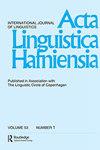词、语言和思想——一种新的语言模式*
Q2 Arts and Humanities
引用次数: 5
摘要
摘要本文从语言的动态认知现实出发,从索绪尔语词与语言的过程统一性出发,对语言的总体结构进行了新的阐释。语言是过程,是用法,是文本,是一种能力,一种能力。这里提供了一个文学上的例子,来自于fcv。词汇具有影响语言每一个子结构的属性,是语言和思维之间的界限。本文章由计算机程序翻译,如有差异,请以英文原文为准。
Word, language, and thought – a new linguistic model*
Abstract This article proposes a new account of the general architecture of language, based on the word and on the processual unity of Saussurean parole and langue in the dynamical cognitive reality of language. Language is process, usage, text, and a capacity, a competence. A literary example, from Félix Fénéon, is offered. It is argued that words have properties affecting every substructure in language and additionally constitute the threshold between language and thought.
求助全文
通过发布文献求助,成功后即可免费获取论文全文。
去求助
来源期刊

Acta Linguistica Hafniensia
Arts and Humanities-Language and Linguistics
CiteScore
0.90
自引率
0.00%
发文量
5
 求助内容:
求助内容: 应助结果提醒方式:
应助结果提醒方式:


